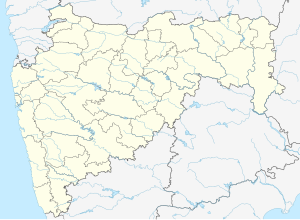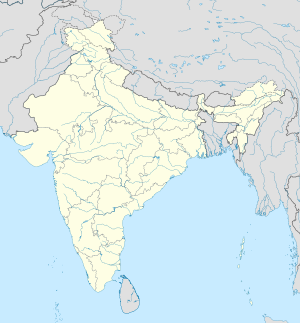Bhushangad: Difference between revisions
Appearance
Content deleted Content added
No edit summary |
BeepBeepBom (talk | contribs) No edit summary |
||
| Line 15: | Line 15: | ||
'''Bhushangad''' is a [[hill fort]] in the [[Khatav]] [[taluk]] of the [[Satara district]] of [[Maharashtra]], [[India]]. It is oval in shape, and rises {{Convert|600|ft|m}} above the surrounding plain. Its top is flat, and measures to be about {{Convert|300|sqyd|m2}} in area.<ref name="bombay">{{cite book|title=Gazetteer of the Bombay Presidency|publisher=Govt Central Press|year=1885|url=https://books.google.com/books?id=LbwIAAAAQAAJ&pg=PA12&dq=bhushangad|access-date=2009-02-21 |page=12}}</ref> |
'''Bhushangad''' is a [[hill fort]] in the [[Khatav]] [[taluk]] of the [[Satara district]] of [[Maharashtra]], [[India]]. It is oval in shape, and rises {{Convert|600|ft|m}} above the surrounding plain. Its top is flat, and measures to be about {{Convert|300|sqyd|m2}} in area.<ref name="bombay">{{cite book|title=Gazetteer of the Bombay Presidency|publisher=Govt Central Press|year=1885|url=https://books.google.com/books?id=LbwIAAAAQAAJ&pg=PA12&dq=bhushangad|access-date=2009-02-21 |page=12}}</ref> |
||
The origins of the fort are unclear. Local legend attributes construction of the fort to King [[Simhana|Singhana]] of Devagiri ( |
The origins of the fort are unclear. Local legend attributes construction of the fort to King [[Simhana|Singhana]] of Devagiri (1210–1246).<ref name="Antiquary">-{{cite journal |year=1898 |title=The Indian Antiquary Vol-xxvii |url=https://ia902907.us.archive.org/24/items/in.ernet.dli.2015.207414/2015.207414.The-Indian_text.pdf |journal=The Journal of Oriental Research |page=250}}</ref> Construction has also been attributed to Shivaji I in 1676,<ref name=Loch>{{cite book|title=Dakhan History|year=1877|url=https://ia601009.us.archive.org/3/items/dakhanhistorymus0000loch/dakhanhistorymus0000loch.pdf |page=595}}</ref> as part of a fortification of the area that included the nearby [[Vardhangad Fort]], [[Sadashivgad]] and [[Machindragad]]. |
||
The fort is home to the only temple of Haranaidevi (an incarnation of [[Durga]]), who is revered by the [[Kulkarni]]s clan. There is also a temple dedicated to [[Hanuman|Maruti]].<ref name="bombay"></ref> |
The fort is home to the only temple of Haranaidevi (an incarnation of [[Durga]]), who is revered by the [[Kulkarni]]s clan. There is also a temple dedicated to [[Hanuman|Maruti]].<ref name="bombay"></ref> |
||
Latest revision as of 16:32, 30 September 2024
| Bhushangad | |
|---|---|
| Satara district, Maharashtra, India | |
 Bhushangad as seen from the plains | |
Shown within Maharashtra | |
| Coordinates | 17°27′53″N 74°24′23″E / 17.4648°N 74.4063°E |
| Type | Hill Fort |
Bhushangad is a hill fort in the Khatav taluk of the Satara district of Maharashtra, India. It is oval in shape, and rises 600 feet (180 m) above the surrounding plain. Its top is flat, and measures to be about 300 square yards (250 m2) in area.[1]
The origins of the fort are unclear. Local legend attributes construction of the fort to King Singhana of Devagiri (1210–1246).[2] Construction has also been attributed to Shivaji I in 1676,[3] as part of a fortification of the area that included the nearby Vardhangad Fort, Sadashivgad and Machindragad.
The fort is home to the only temple of Haranaidevi (an incarnation of Durga), who is revered by the Kulkarnis clan. There is also a temple dedicated to Maruti.[1]
References
[edit]- ^ a b Gazetteer of the Bombay Presidency. Govt Central Press. 1885. p. 12. Retrieved 21 February 2009.
- ^ -"The Indian Antiquary Vol-xxvii" (PDF). The Journal of Oriental Research: 250. 1898.
- ^ Dakhan History (PDF). 1877. p. 595.



